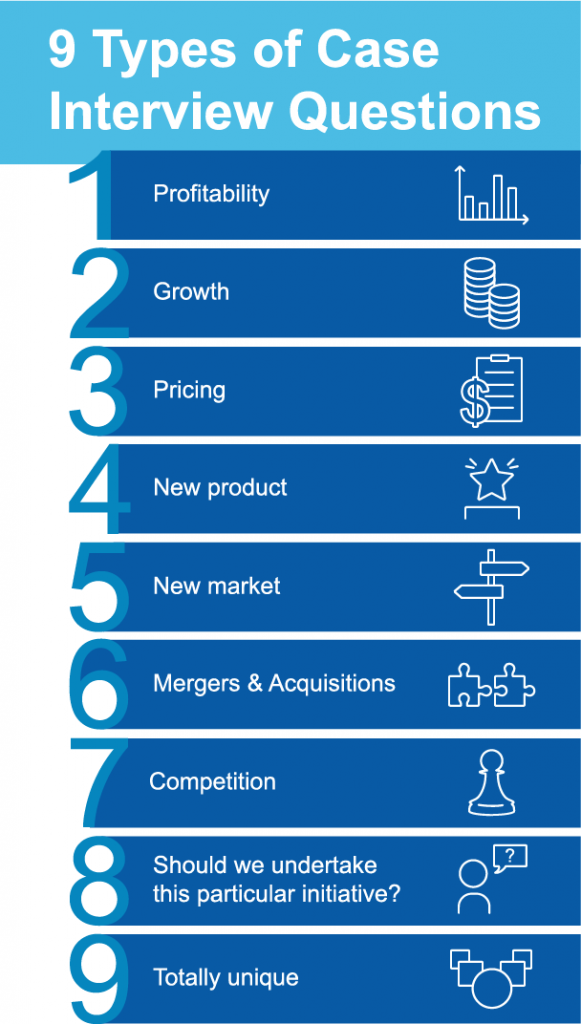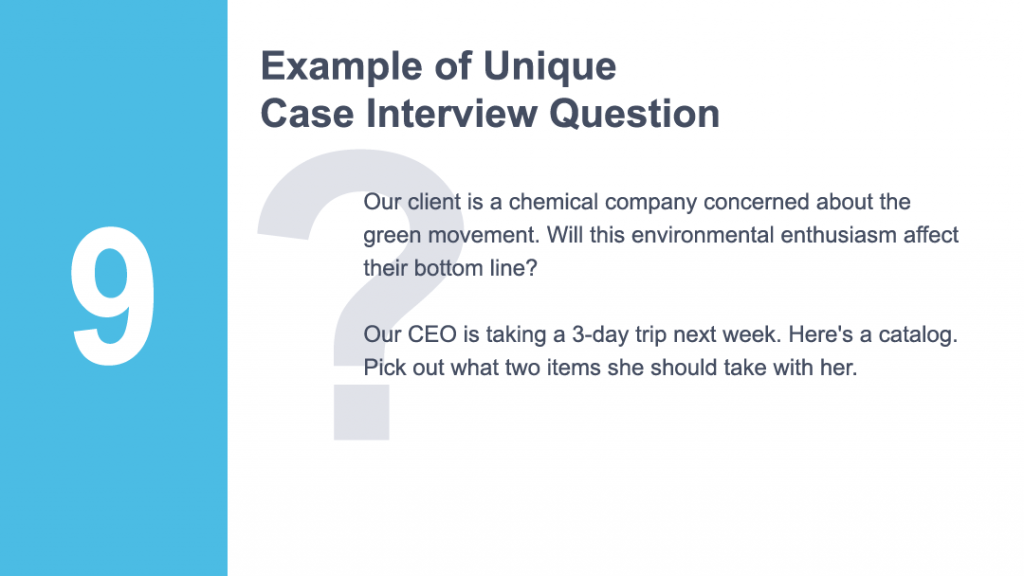You can perform better in a consulting interview by having an upfront preview of what types of questions might be thrown your way. Below you’ll find nine categories of questions and a few tips on areas worth exploring within each:
1) Profitability
Profitability cases directly tackle the amount of money a business is generating. For example:
If you’re tackling a profitability problem, don’t be shy about going directly after the drivers of profitability — revenue and cost. You can split revenue down further into quantities, prices, and product mix. Segment the revenues however helpful. Then be sure to examine both the fixed and variable costs.
Often looking at revenue first provides clues as to what may be driving the costs. If possible, some benchmark data — either internally (against different stores, regions, plants, etc.) or externally (against competitors) can really help shed light on what might be going on inside the company.
2) Growth
Growth cases are all about a company getting bigger–usually in terms of dollars of revenue, but the measure might also be market share or number of customers. For example:
Mathematically, the only ways to grow revenues are to increase quantity sold or the price per unit sold. This mathematical thought process can add some useful structure to your approach, but don’t let it curtail your creative thought process.
A company can grow by expanding or adding new forms of distribution channels (e.g. retail stores, online, catalogs, or affiliate partners). It can also introduce new products or tweak existing products to better satisfy their customers. They can also refresh their sales and marketing approaches. Finally, they can grow in giant steps by acquiring another whole company.
3) Pricing
Consulting interview questions about pricing ask for the optimal price — or way to determine the optimal price — for a given product or service. For example:
When it comes to determining prices, there are three basic ways to frame your approach. The first is cost-based pricing. This tends to be how engineers think of pricing. You determine your cost per unit, then add a reasonable margin on top of that. This is an incomplete approach, but it does help give you some perspective on the minimum possible price.
The second is alternative-based pricing. With this approach, you look at how the alternatives (e.g. competitors or substitute) are priced and how your product stacks up against these alternatives.
The final approach is the customer’s maximum willingness to pay. Think about the ultimate underlying benefit created by the product (e.g. cost-savings, time-savings) and attempt to put a dollar amount on it. For example, if a product reduces the time a heart surgery takes by 10 minutes, and you can calculate the total hourly cost of running the operating team, 1/6th of that amount gives you an estimate of the value of that time saved.
Generally, the cost-based approach will give you a theoretical floor for the price (if you sold for any less, you’d be losing money), while the willingness to pay approach offers you a theoretical ceiling (no logical customer will ever pay any more than that). Getting the final price often depends on using qualitative factors to choose a reasonable figure somewhere between the two.
4) New product
New product cases deal with a fresh invention or idea for a company. For example:
New product cases require you to take a look at a wide variety of issues. A basic understanding of the product, company, customers, competition, and go-to-market approach will be critical.
Some new product cases delve into the numbers associated with expected costs and prices. When these numbers materialize, interviewers often want you to calculate a breakeven volume (or the volume necessary to reach pre-determined business goals) and determine if such a volume is achievable.
5) New market
New market cases are similar to new product cases, except they tend to be broader and require a global perspective on a whole industry. For instance:
When evaluating the attractiveness of a new market, Porter’s Five Forces provides a great starting point to think through. The forces to consider are: threat of new competition, threat of substitutes, bargaining power of buyers (your customers), bargaining power of suppliers, and competitive intensity.
Knowing the general attractiveness of the market is a great first step. You’ll also want to know if your client is a good fit for entering the market and what approach they’ll use to enter that market.
6) Mergers and Acquisitions
M&A cases are all about the implications associated with rolling another company into an existing one. They might sound like:
Before the merger, think through whether the target is a good fit and can be acquired at a good price that meets the business’s objectives. Calculating synergies is all about identifying overlap opportunities.
On the cost side, determine how much each is spending on overlapping items.For instance, if both are purchasing potatoes, but one company is getting a 20% better price, apply that 20% savings to the amount of spend occurring at a less-favorable price. That approach will estimate how much one could save if the company were able to realize the per-unit pricing that the other company is getting.
On the revenue synergy side, it helps to think about cross-selling opportunities and expand the products sold to each company’s customer list by including the new offerings made available through the merger.
7) Competition
Consulting interview questions about competition deal with beating out other industry contenders or responding to something they’ve done. For example:
Competition cases can take many different twists and turns. It’s ideal to understand the full implications associated with the competitive move and then use other case approaches as necessary.
If it’s a declining market share scenario, it’s ideal to understand potential changes in customer preferences and how well they’re being met. If it’s a price war scenario, it’s key to understand how loyal the customers are and the relative cost base.
8 ) Should we undertake this particular initiative?
These consulting interview questions are really just other types of cases thinly-veiled. For example:
Whenever you hear a “should,” think, “based on what objectives?” First, get real clarity on the objectives. Asking about the goals of the loyalty program may quickly reveal that you’re really trying to determine whether having a loyalty program will generate more profit than not having one. Then you’re off to evaluating revenue and cost in each scenario.
9) Totally unique
Some consulting interview questions fall completely beyond categorization. For example:
When you get a case that seems to fall way outside the bounds of a traditional consulting interview question, stay calm. All the normal case interview rules apply. You’ll still want to clarify the objectives, hypothesis, provide a plan, be data-driven, and deliver a succinct recommendation. It just might sound a little different in the process.
Having a familiarity with these types of consulting interview questions will reduce the odds of getting caught off-guard when the moment strikes, and will help you to “ace the case“. But don’t spend too much time agonizing over the list. It’s really not a good use of your efforts to try and memorize all of these.
Rather, the value comes from having done a quick preview to plant some seeds that sharpen your ability to identify relevant issues. Remember: the case interview is primarily a test of problem-solving — not memorization.











1 thought on “Consulting Interview Questions”
Super helpful – thank you!!